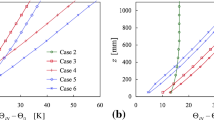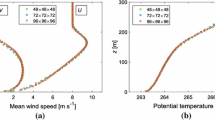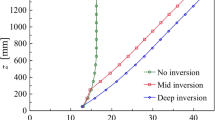Abstract
A range of large-eddy simulations, with differing free atmosphere stratification and zero or slightly positive surface heat flux, is investigated to improve understanding of the neutral and near-neutral, inversion-capped, horizontally homogeneous, barotropic atmospheric boundary layer with emphasis on the upper region. We find that an adjustment time of at least 16 h is needed for the simulated flow to reach a quasi-steady state. The boundary layer continues to grow, but at a slow rate that changes little after 8 h of simulation time. A common feature of the neutral simulations is the development of a super-geostrophic jet near the top of the boundary layer. The analytical wind-shear models included do not account for such a jet, and the best agreement with simulated wind shear is seen in cases with weak stratification above the boundary layer. Increasing the surface heat flux decreases the magnitude and vertical extent of the jet and leads to better agreement between analytical and simulated wind-speed profiles. Over a range of different inversion strengths and surface heat fluxes, we also find good agreement between the performed simulations and models of the equilibrium boundary-layer height, and of the budget of turbulent kinetic energy integrated across the boundary layer.
















Similar content being viewed by others
Notes
The subfilter shear production is compensated by the downscale transfer of TKE from resolved to subgrid scales (Wyngaard 2010), so the shear production in the total budget appears only at resolved scales here in our homogeneous cases.
References
Abkar M, Porté-Agel F (2013) The effect of free-atmosphere stratification on boundary-layer flow and power output from very large wind farms. Energies 6:2338–2361
Andren A, Brown AR, Graf J, Mason PJ, Moeng CH, Nieuwstadt FTM, Schumann U (1994) Large-eddy simulation of a neutrally stratified boundary layer: a comparison of four computer codes. Q J R Meteorol Soc 120:1457–1484
Basu S, Vinuesa JF, Swift A (2008) Dynamic LES modeling of a diurnal cycle. J Appl Meteorol Clim 47:1156–1174
Batchvarova E, Gryning SE (1991) Applied model for the growth of the daytime mixed layer. Boundary-Layer Meteorol 56:261–274
Batchvarova E, Gryning SE, Skov H, Sørensen LL, Kirova H, Münkel C (2013) Boundary-layer and air quality study at “Station Nord” in Greenland. In: Steyn DG, Mathur R (eds) 33rd International Technical Meeting on Air Pollution Modelling and Its Application
Brasseur JG, Wei T (2010) Designing large-eddy simulation of the turbulent boundary layer to capture law-of-the-wall scaling. Phys Fluids 22:021303
Deardorff JW (1980) Stratocumulus-capped mixed layers derived from a three-dimensional model. Boundary-Layer Meteorol 18:495–527
Esau I (2004) Simulation of ekman boundary layers by large eddy model with dynamic mixed subfilter closure. Environ Fluid Mech 4:273–303
Esau I, Davy R, Outten S, Tyuryakov S, Zilitinkevich S (2013) Structuring of turbulence and its impact on basic features of ekman boundary layers. Nonlin Process Geophys 20:589–604
Grisogono B (1995) A generalized ekman layer profile with gradually varying eddy diffusivities. Q J R Meteorol Soc 121:445–453
Gryning SE, Batchvarova E, Brümmer B, Jørgensen H, Larsen S (2007) On the extension of the wind profile over homogeneous terrain beyond the surface boundary layer. Boundary-Layer Meteorol 124:251–268
Hess GD (2004) The neutral, barotropic planetary boundary layer, capped by a low-level inversion. Boundary-Layer Meteorol 110:319–355
Kelly M, Gryning SE (2010) Long-term mean wind profiles based on similarity theory. Boundary-Layer Meteorol 136:377–390
Klemp JB, Durran DR (1983) An upper boundary condition permitting internal gravity wave radiation in numerical mesoscale models. Mon Weather Rev 111:430–444
Kosović B (1997) Subgrid-scale modelling for the large-eddy simulation of high-Reynolds-number boundary layers. J Fluid Mech 336:151–182
Kumar V, Svensson G, Holtslag AAM, Meneveau C, Parlange MB (2010) Impact of surface flux formulations and geostrophic forcing on large-eddy simulations of diurnal atmospheric boundary layer flow. J Appl Meteorol Clim 49:1496–1516
Lin CL, McWilliams JC, Moeng CH, Sullivan PP (1996) Coherent structures and dynamics in a neutrally stratified planetary boundary layer flow. Phys Fluids 8:2626–2639
Mason PJ, Thomson DJ (1987) Large-eddy simulations of the neutral-static-stability planetary boundary layer. Q J R Meteorol Soc 113:413–443
Mirocha J, Kirkil G, Bou-Zeid E, Chow FK, Kosović B (2013) Transition and equilibration of neutral atmospheric boundary layer flow in one-way nested large-eddy simulations using the weather research and forecasting model. Mon Weather Rev 141:918–940
Moeng CH (1984) A large-eddy-simulation model for the study of planetary boundary-layer turbulence. J Atmos Sci 41:2052–2062
Moeng CH, Sullivan PP (1994) A comparison of shear- and buoyancy-driven planetary boundary layer flows. J Atmos Sci 51:999–1022
Moeng CH, Wyngaard JC (1988) Spectral analysis of large-eddy simulations of the convective boundary layer. J Atmos Sci 45:3573–3587
Otte MJ, Wyngaard JC (2001) Stably stratified interfacial-layer turbulence from large-eddy simulation. J Atmos Sci 58:3424–3442
Pedersen JG, Kelly M, Gryning SE, Brümmer B (2013) The effect of unsteady and baroclinic forcing on predicted wind profiles in Large Eddy Simulations: Two case studies of the daytime atmospheric boundary layer. Meteorol Z 22:661–674
Porté-Agel F, Meneveau C, Parlange MB (2000) A scale-dependent dynamic model for large-eddy simulation: application to a neutral atmospheric boundary layer. J Fluid Mech 415:261–284
Rossby CG, Montgomery RB (1935) The layer of frictional influence in wind and ocean currents. Pap Phys Oceanogr Meteorol 3:1–101
Stoll R, Porté-Agel F (2006) Dynamic subgrid-scale models for momentum and scalar fluxes in large-eddy simulations of neutrally stratified atmospheric boundary layers over heterogeneous terrain. Water Resour Res 42(1):W01409
Sullivan PP, Patton EG (2011) The effect of mesh resolution on convective boundary layer statistics and structures generated by large-eddy simulation. J Atmos Sci 68:2395–2415
Sullivan PP, McWilliams JC, Moeng CH (1994) A subgrid-scale model for large-eddy simulation of planetary boundary-layer flows. Boundary-Layer Meteorol 71:247–276
Sullivan PP, McWilliams JC, Moeng CH (1996) A grid nesting method for large-eddy simulation of planetary boundary-layer flows. Boundary-Layer Meteorol 80:167–202
Taylor J, Sarkar S, Armenio V (2005) Large eddy simulation of stably stratified open channel flow. Phys Fluids 17:116602
Wyngaard JC (2010) Turbulence in the atmosphere. Cambridge University Press, New York, 392 pp
Zilitinkevich S, Esau I, Baklanov A (2007) Further comments on the equilibrium height of neutral and stable planetary boundary layers. Q J R Meteorol Soc 133:265–271
Zilitinkevich S, Elperin T, Kleeorin N, Rogachevskii I, Esau I (2013) A hierarchy of energy- and flux-budget (efb) turbulence closure models for stably-stratified geophysical flows. Boundary-Layer Meteorol 146:341–373
Zilitinkevich SS, Esau IN (2005) Resistance and heat-transfer laws for stable and neutral planetary boundary layers: old theory advanced and re-evaluated. Q J R Meteorol Soc 131:1863–1982
Zilitinkevich SS, Tyuryakov SA, Troitskaya YI, Mareev EA (2012) Theoretical models of the height of the atmospheric boundary layer and turbulent entrainment at its upper boundary. Izv Atmos Ocean Phys 48:133–142
Acknowledgments
The study was supported by the Danish Council for Strategic Research, project number 2104-08-0025 named Tall Wind. We would like to thank Branko Kosović for valuable cooperation.
Author information
Authors and Affiliations
Corresponding author
Rights and permissions
About this article
Cite this article
Pedersen, J.G., Gryning, SE. & Kelly, M. On the Structure and Adjustment of Inversion-Capped Neutral Atmospheric Boundary-Layer Flows: Large-Eddy Simulation Study. Boundary-Layer Meteorol 153, 43–62 (2014). https://doi.org/10.1007/s10546-014-9937-z
Received:
Accepted:
Published:
Issue Date:
DOI: https://doi.org/10.1007/s10546-014-9937-z




